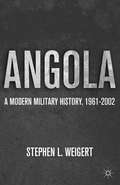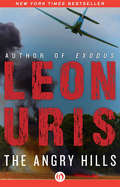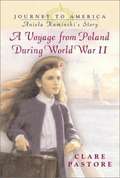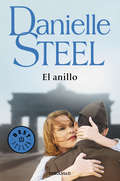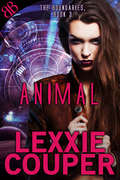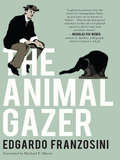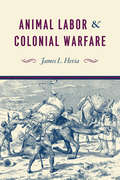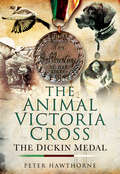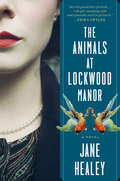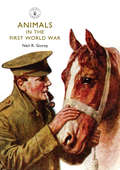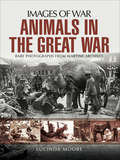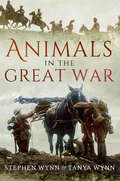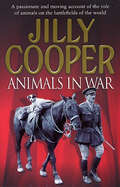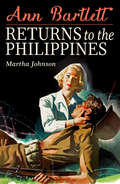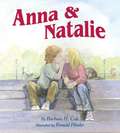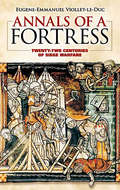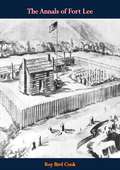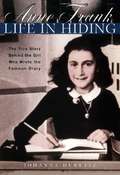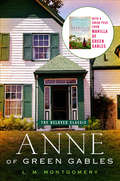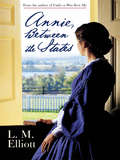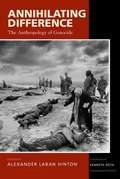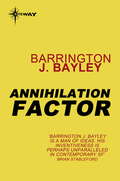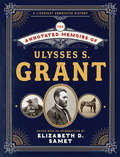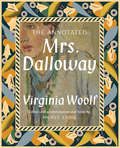- Table View
- List View
Angola: A Modern Military History, 1961-2002
by Stephen L. WeigertThis study is the first comprehensive assessment of warfare in Angola to cover all three phases of the nation's modern history: the anti-colonial struggle, the Cold War phase, and the post-Cold War era. It also covers, in detail, the final phase of warfare in Angola, culminating in Jonas Savimbi's death and the signing of the Luena Accord
The Angry Hills
by Leon UrisA writer moves to Greece just as the Nazis invade, and he soon becomes a pawn in a dangerous game of espionage After the death of his wife, Mike Morrison arrives in Greece simply to receive an inheritance and come to grips with his grief. But it's a bad time to nurse his sorrow--it's the beginning of World War II, and the German army storms the country before Morrison can leave. He's soon caught in a complicated cat-and-mouse game with Gestapo officers, British spies, and the Greek resistance movement. At the mercy of strangers, Morrison has to learn who to trust--and who to love. Leon Uris's fast-paced second novel draws from the diaries of an uncle who served in Greece during World War II. It was made into a film in 1959 starring Robert Mitchum. This ebook features an illustrated biography of Leon Uris including rare photos from the author's estate.
Aniela Kaminski's Story: A Voyage from Poland during World War II (Journey to America Series)
by Clare PastoreThey left their homelands during the worst moments in history and arrived in America ready to reach for their dreams. These are their stories... Dear Jadzia,I thought Papa and I would never make it out of Poland. I was afraid the Nazis would find us and send us to jail. After Stefan was arrested, I knew it could happen to us, too. Do you have any news of him? I hope and pray that he is safe. And Edith, too. It makes me angry to think that people hate her just because she is Jewish. You would love America. Life is so much better here. We are staying with my aunt and uncle in a city called Chicago, and there is lots of good food to eat. And guess what? I might even start taking piano lessons again! I wish you were here, Jadzia. I miss you so very much... Your friend, Aniela
El anillo (Nueva Fontana Ser.)
by Danielle SteelUna historia de amor y lucha frente a las adversidades ambientada en la Alemania de la Segunda Guerra Mundial. En una Alemania inmersa en la guerra y el odio, la joven Ariana von Gotthard recibe el más preciado legado familiar: un anillo. Este se convertirá en símbolo del hogar perdido, pues tras ser separada de su familia, y sin posibilidad de escapar del país, Ariana es arrestada por los nazis. El amor, sin embargo, la salva de las más sombrías perspectivas y le brinda la oportunidad de huir al extranjero. Un viaje no exento de tragedias conduce a Ariana a Estados Unidos, hacia una vida incierta entre gente desconocida y temores nuevos. Ariana queda reducida a una mujer sin pasado y sin futuro, y el anillo al que todavía se aferra es el único recuerdo que guarda de su padre y su hermano. Lo que no sabe es que, con el paso del tiempo, el anillo le servirá como puente entre lo que dejó atrás y el provenir.
Animal (The\boundaries Ser. #3)
by Lexxie CouperDanger lurks in the farthest reaches of space, where sex is a reward and a weapon, alien drug lords blight the landscape, and assassination is a means to an end. Animal by award winning sci-fi paranormal author Lexxie Couper, is Book 3 of The Boundaries series. Get ready for another thrilling ride to distant planets, where the lines between friend and foe are blurred.The stunning conclusion to The Boundaries trilogy begins...The brutal crime lord Hrung Crortek has seized Terran Boundary Guardian Zeric Arctos, hoping to extract Zeric's werewolf DNA for use in an illegal genetic serum. Now Jaienna Ti, Intel-Patrol Corp agent and sexual assassin, is on a mission to wipe Crortek from existence-and she's taking her ex-partner Raq Tornada along for the ride!But when Tornada finally reveals-in no uncertain terms-how deeply he's in love with her, Jaienna faces a completely unexpected conflict: does she stay with the man who first shattered her heart, or does she go with the man who taught her to love again-the brooding, untameable werewolf she's trying so desperately to save?When lust, love, and longing become inextricably entwined, the Outer Boundaries become more dangerous than ever. Because Jaienna never planned on losing her heart to two men. And those two men never ever planned on sharing her. But unless Raq Tornada agrees to help Jaienna rescue his rival, Zeric Arctos is already doomed...This erotic sci-fi paranormal romance contains wild explosive sex in space, and is not intended for readers under the age of 18.Previously Published: (2011) 5x5 Publishing
The Animal Gazer
by Edgardo FranzosiniA poignant biographical novel about a WWI-era sculptor: “It’s difficult not to love the eccentric, fragile Rembrandt Bugatti and suffer alongside him” (The New York Times Book Review). The Animal Gazer is a hypnotic novel inspired by the strange and fascinating life of sculptor Rembrandt Bugatti, brother of the fabled automaker. With World War I closing in and the Belle Époque teetering to a end, Bugatti leaves his native Milan for Paris, where he encounters Rodin and casts his bronzes at the same foundry used by the French master. In Paris and then Antwerp, he obsessively observes and sculpts the baboons, giraffes, and panthers in the municipal zoos, finding empathy with their plight and identifying with their life in captivity. But as the Germans drop bombs over the Belgian city, the zoo authorities are forced to make a heart-wrenching decision about the fate of the caged animals, and Bugatti is stricken with grief from which he’ll never recover. Rembrandt Bugatti’s work is displayed in major museums around the world, and in this prize-winning novel, “an irresistible, elegantly conceived example of biographical fiction,” Edgardo Franzosini recreates the young artist’s life with lyricism, passion, and sensitivity (Library Journal). “The Animal Gazer takes you on a glorious journey into the heart of cosmopolitan Paris as you have never known it before. Through the life of Rembrandt Bugatti, a sculptor with the panache of his name, this lively, fast-paced narrative evokes an exceptional epoch in all its color and eccentric charm.” ―Nicholas Fox Weber, author of Le Corbusier: A Life
Animal Labor and Colonial Warfare
by James L. HeviaUntil well into the twentieth century, pack animals were the primary mode of transport for supplying armies in the field. The British Indian Army was no exception. In the late nineteenth century, for example, it forcibly pressed into service thousands of camels of the Indus River basin to move supplies into and out of contested areas—a system that wreaked havoc on the delicately balanced multispecies environment of humans, animals, plants, and microbes living in this region of Northwest India. In Animal Labor and Colonial Warfare, James Hevia examines the use of camels, mules, and donkeys in colonial campaigns of conquest and pacification, starting with the Second Afghan War—during which an astonishing 50,000 to 60,000 camels perished—and ending in the early twentieth century. Hevia explains how during the nineteenth and twentieth centuries a new set of human-animal relations were created as European powers and the United States expanded their colonial possessions and attempted to put both local economies and ecologies in the service of resource extraction. The results were devastating to animals and human communities alike, disrupting centuries-old ecological and economic relationships. And those effects were lasting: Hevia shows how a number of the key issues faced by the postcolonial nation-state of Pakistan—such as shortages of clean water for agriculture, humans, and animals, and limited resources for dealing with infectious diseases—can be directly traced to decisions made in the colonial past. An innovative study of an underexplored historical moment, Animal Labor and Colonial Warfare opens up the animal studies to non-Western contexts and provides an empirically rich contribution to the emerging field of multispecies historical ecology.
The Animal Victoria Cross: The Dickin Medal
by Peter HawthorneSixty-three animals have won the Dickin Medal, the highest award for animal bravery. Their inspiring stories are told, for the first time in one book, The Animal Victoria Cross. Four types of animal have been honored, dogs, horses, pigeons and one cat. Simon, the feline, is credited with saving an entire ships crew. Canine breeds include Alsatians, Terriers, Collies and Spaniels. The majority of awards were related to war service and the conflicts include the Second World War, Korea, Iraq, Yugoslavia and Afghanistan. The Al-Qaeda attack on the Twin Towers as well as the Blitz saw great courage exhibited by animals such as Rip, the dog who saved many lives. In addition to British animals, there are American, Canadian, Australian and Egyptian winners of this unique award. Animal lovers everywhere will treasure this delightful book. It is ideal to dip into or read from cover to cover.
The Animals at Lockwood Manor
by Jane HealeyA debut novel for fans of Sarah Perry and Kate Morton: when a young woman is tasked with safeguarding a natural history collection as it is spirited out of London during World War II, she discovers her new manor home is a place of secrets and terror instead of protection.In August 1939, thirty-year-old Hetty Cartwright arrives at Lockwood Manor to oversee a natural history museum collection, whose contents have been taken out of London for safekeeping. She is unprepared for the scale of protecting her charges from party guests, wild animals, the elements, the tyrannical Major Lockwood and Luftwaffe bombs. Most of all, she is unprepared for the beautiful and haunted Lucy Lockwood. For Lucy, who has spent much of her life cloistered at Lockwood suffering from bad nerves, the arrival of the museum brings with it new freedoms. But it also resurfaces memories of her late mother, and nightmares in which Lucy roams Lockwood hunting for something she has lost. When the animals appear to move of their own accord, and exhibits go missing, they begin to wonder what exactly it is that they might need protection from. And as the disasters mount up, it is not only Hetty&’s future employment that is in danger, but her own sanity too. There&’s something, or someone, in the house. Someone stalking her through its darkened corridors . . .
Animals in the First World War
by Neil StoreyAnimals played an important part in helping the Allies win the First World War, well beyond cavalry horses that charged fields and hauled heavy guns, and included a variety of animals in different but essential service. Pigeons were trained to carry messages, dogs sniffed out wounded soldiers on battlefields, and camels were used for desert transport on the frontlines. Some animals acted as vital morale boosters and mascots like ships' cats even baby orangutans! This book examines the jobs that these animals did, achieving heroic feats and simple acts of loyalty and companionship, all with enormous value in winning the war for the Allies.
Animals in the Great War (Images of War)
by Lucinda MooreTails from the Great War throws a spot light on the experience of creatures great and small during the First World War, vividly telling their stories through the incredible archival images of the Mary Evans Picture Library. The enduring public interest in Michael Morpurgos tale of the war horse reveals an enthusiasm for the animal perspective on war, but what of the untold stories of the war dog, the trench rat or even the ships pig? Through unrivaled access to rarely seen illustrated wartime magazines, books and postcards, discover the sea lions who were trained to detect submarines, and witness the carcass of the 61ft mine-destroying wonder whale. Meet the dog that brought a sailor back from the brink of death, and inspired a Hollywood legend. See how depictions of animals were powerfully manipulated by the propaganda machine on both sides, and how the presence of animals could bring much needed and even lifesaving companionship and cheer amid the carnage of war. As the centenary of the Great War is commemorated all over the world, take a timely journey via the lens of Mary Evans wartime images, and marvel at the often overlooked but significant contribution and experience of animals at war. By turns astonishing, heart-warming and occasionally downright bizarre, Tails from the Great War champions the little-known story of the bison, the chameleon, the canary et al in wartime.
Animals in the Great War
by Stephen Wynn Tanya Wynn&“Cats, rabbits and even the bear that inspired Winnie the Pooh appear in remarkable photos of the 16 million animals caught up in World War One.&” —DailyMail.com Animals in the Great War looks at the use of animals by all sides in the Great War and to what effect. In the main, it focuses greatly on horses, dogs and pigeons but also addresses the war efforts of other animals. In the early years of the war horses were, to a large extent, the only form of transport that was available to the British Army, ranging from use by cavalry units, artillery units as well others such as the Army Ordnance Corps for the conveying of ammunition supplies to men fighting at the front. Britain sent an estimated one million horses to fight in the war, most of them to France and Belgium, but only 60,000 of them ever returned home, and only then were they returned because of the intervention of Winston Churchill. Dogs also played a major role in the war, especially in the trenches on the Western Front. They were used as mascots by the different regiments and in some cases, they were companions for homesick soldiers. They were also used for sentry duties in the trenches as well as catching rats, and they were used as messengers and to sniff out wounded soldiers in No Man&’s Land. Animals in the Great War explores how everyday domestic animals were transformed into remarkable wartime heroes, who more than did their bit for the war effort.
Animals In War
by Jilly Cooper OBEPigeons carrying vital messages to and from the beleaguered city during the Siege of Paris; horses and mules struggling through miles of fetid mud to bring ammunition to the front in the Great War; dogs sniffing out mines for the British invasion force in the Second World War - countless brave animals have played their part in the long, cruel history of war. Some have won medals for gallantry - like G.I. Joe, the American pigeon who saved 100 British lives in Italy, and Rob, the black and white mongrel who made over twenty parachute jumps with the SAS. Too many others have died abandoned, in agony and alone, after serving their country with distinction. Jilly Cooper has here written a tribute to the role of animals in wartime. It is a tragic and horrifying story - yet it has its lighter moments too: a hilarious game of musical chairs played on camels during the Desert Campaign; and the budgie who remarked, when carried from a bombed-out East End tenement, 'This is my night out'. This is a vivid and unforgettable record of man's inhumanity to animals, but also an astonishing story of courage, intelligence, devotion and resilience.
Ann Bartlett Returns to the Philippines
by Martha JohnsonAnn Bartlett Returns to the Philippines, first published in 1945, is an exciting historical-fiction novel centering on Navy nurse Ann Bartlett and her friend and fellow nurse Evelyn Baldwin; location: the occupied Philippines during World War II. The pair travel from the U.S. to the Philippines and serve as nurses aboard a ship. Upon reaching the Philippines, their adventures begin as Ann boards a lifeboat searching for survivors of a nearby ship that has gone down following a Japanese attack; foggy weather separates the lifeboat from the ship, and when the weather clears, a Japanese airplane machine-guns the boat, forcing the passengers into the water. The story continues with the survivors reaching an island shore, narrow escapes from the Japanese, and a romance. Five ‘Ann Bartlett’ books were published by author Martha Johnson between 1941-1946.
Anna and Natalie
by Barbara H. ColeAnna is never picked to be on any team at school. But she is determined to be chosen when Mrs. Randall announces a letter-writing contest to decide which four students will be part of the wreath-laying team at the Tomb of the Unknown Soldier in Arlington, Virginia. This moving story of how Anna deals with her disability will touch the hearts of all readers as they cheer her on to the surprise ending.
Annals of a Fortress: Twenty-two Centuries of Siege Warfare
by Eugene-Emmanuel Viollet-le-Duc Benjamin BucknallCombining the excitement of a novel with the authenticity of a historical document, this gripping book chronicles a castle's rise from obscurity to international attention during the nineteenth century. It profiles a fictional fortress, La Roche-Pont, for an unusual survey of the evolving art of siege warfare--from Gallic tribes attempting to hold off the might of the Roman empire through medieval feuds, protracted religious conflicts of the seventeenth century, and the Napoleonic and Franco-Prussian Wars.The noted architect Eugene-Emmanuel Viollet-le-Duc (1814-1879) was in a unique position to write this book. A central figure in France's Gothic Revival, Viollet-le-Duc had a second career in the military that included a prominent role in the defense of Paris during the Franco-Prussian War of the 1870s. With this accessible, well-researched study, he exerted an enduring influence on French military defensive thinking. Subtle and enchanting in its blend of fact and fiction, Annals of a Fortress continues to offer a brilliant evocation of more than 2,000 years of European warfare.
The Annals of Fort Lee
by Roy Bird CookFort Lee was built in 1788 on the site of what is now Charleston, West Virginia, at the junction of the Kanawha River and the Elk River. It is named for Virginia Governor Henry (Light Horse Harry) Lee, and played a great part in the Indian wars of that area until they came to an end in 1794. The fort was established by a group of men led by the Clendenin brothers George and William, for whose father Charles the city of Charleston was later named. The fort's early history was fraught with difficulties getting lead, powder and pay (with the capital at Richmond being far away over the mountains), but it contributed to an organized system of defense to stop the Indian raids from driving the settlers from their homes. The book discusses George Washington, who owned property nearby, and Daniel Boone, who was appointed Lieutenant Colonel of the Kanawha and took up residence quite near the fort. Readers will learn of "Mad Ann Bailey," who carried powder unmolested by Indians because they thought her insane, and others whose determination aided frontier defense. Following Mad Anthony Wayne's success against the Indians on the western border, Fort Lee ceased to have any connection with the Virginia military system by the end of 1795, and became simply a residence in Charleston. The fort building was subsequently moved a couple of times and was finally consumed by fire in 1891, except for a couple of logs from which souvenirs were made.-Print ed.
Anne Frank: Life in Hiding
by Johanna HurwitzIn this sensitive introduction to the Holocaust and to the life of the little girl who hid out and kept a diary during World War II, this acclaimed author deftly evokes the background of the war while capturing the girl's unforgettable spirit.
Anne of Green Gables (Anne Of Green Gables Ser. #1)
by L. M. MontgomeryThe beloved classic story from L.M. Montgomery of the orphan who captured readers’ hearts around the world—now includes an excerpt from Sarah McCoy’s novel Marilla of Green Gables—a bold, heartfelt tale of life at Green Gables . . . before Anne.Marilla and Mathew Cuthbert had planned to adopt a boy to help out around Green Gables farm. But waiting for Mathew at the train station is freckle-faced, red-headed Anne Shirley—a talkative eleven-year-old orphan with a heart full of dreams and a desperate longing for a home.From the moment Anne arrives, Green Gables will be transformed forever.
Annie, Between the States
by L. M. ElliottAnnie's home and heart are divided by the Civil War.Annie Sinclair's Virginia home is in the battle path of the Civil War. <P><P> Her brothers, Laurence and Jamie, fight to defend the South, while Annie and her mother tend to wounded soldiers. <P><P>When she develops a romantic connection with a Union Army lieutenant, Annie's view of the war broadens. <P>Then an accusation calls her loyalty into question. A nation and a heart divided force Annie to choose her own course.
Annie, Between the States
by L. M. ElliottAnnie's home and heart are divided by the Civil War. Annie Sinclair's Virginia home is in the battle path of the Civil War. Her brothers, Laurence and Jamie, fight to defend the South, while Annie and her mother tend to wounded soldiers. When she develops a romantic connection with a Union Army lieutenant, Annie's view of the war broadens. Then an accusation calls her loyalty into question. A nation and a heart divided force Annie to choose her own course.
Annihilating Difference: The Anthropology of Genocide
by Alexander Laban HintonThis collection of original essays on genocide explores a wide range of cases, including Nazi Germany, Cambodia, Guatemala, Rwanda, and Bosnia.
Annihilation Factor
by Barrington J. BayleyFrom the Garlowe Clusters in the north to the Veils of Darkness in the south, the Star Kingdom sprawled over roughly a fifth of the galaxy. So huge was this realm that those who tussled for power over it seemed unable to appreciate that it faced annihilation by the Patch, a roving region of peculiar pseudo-energy a light-year across which drained the life-force from any living thing it encountered.The Patch had moved into the Kingdom and was systematically feeding on system after system. Cynically unperturbed by the appalling loss of life, the royal houses merely tried to involve the Patch in their machinations, to the extent that civil war broke out all over again. But in the event, the Patch was to provide the crucial factor in the struggle for absolute power. The Annihilation Factor!
The Annotated Memoirs of Ulysses S. Grant
by Ulysses S. Grant Elizabeth D. SametWith kaleidoscopic, trenchant, path-breaking insights, Elizabeth D. Samet has produced the most ambitious edition of Ulysses Grant’s Memoirs yet published. One hundred and thirty-three years after its 1885 publication by Mark Twain, Elizabeth Samet has annotated this lavish edition of Grant’s landmark memoir, and expands the Civil War backdrop against which this monumental American life is typically read. No previous edition combines such a sweep of historical and cultural contexts with the literary authority that Samet, an English professor obsessed with Grant for decades, brings to the table. Whether exploring novels Grant read at West Point or presenting majestic images culled from archives, Samet curates a richly annotated, highly collectible edition that will fascinate Civil War buffs. The edition also breaks new ground in its attack on the “Lost Cause” revisionism that still distorts our national conversation about the legacy of the Civil War. Never has Grant’s transformation from tanner’s son to military leader been more insightfully and passionately explained than in this timely edition, appearing on the 150th anniversary of Grant’s 1868 presidential election.
The Annotated Mrs. Dalloway
by Merve Emre Virginia WoolfVirginia Woolf’s groundbreaking novel, in a lushly illustrated hardcover edition with illuminating commentary from a brilliant young Oxford scholar and critic. “Mrs. Dalloway said she would buy the flowers herself.” So begins Virginia Woolf’s much-beloved fourth novel. First published in 1925, Mrs. Dalloway has long been viewed not only as Woolf’s masterpiece, but as a pivotal work of literary modernism and one of the most significant and influential novels of the twentieth century. In this visually powerful annotated edition, acclaimed Oxford don and literary critic Merve Emre gives us an authoritative version of this landmark novel, supporting it with generous commentary that reveals Woolf’s aesthetic and political ambitions—in Mrs. Dalloway and beyond—as never before. Mrs. Dalloway famously takes place over the course of a single day in late June, its plot centering on the upper-class Londoner Clarissa Dalloway, who is preparing to throw a party that evening for the nation’s elite. But the novel is complicated by Woolf’s satire of the English social system, and by her groundbreaking representation of consciousness. The events of the novel flow through the minds and thoughts of Clarissa and her former lover Peter Walsh and others in their circle, but also through shopkeepers and servants, among others. Together Woolf’s characters—each a jumble of memories and perceptions—create a broad portrait of a city and society transformed by the Great War in ways subtle but profound ways. No figure has been more directly shaped by the conflict than the disturbed veteran Septimus Smith, who is plagued by hallucinations of a friend who died in battle, and who becomes the unexpected second hinge of the novel, alongside Clarissa, even though—in one of Woolf’s many radical decisions—the two never meet. Emre’s extensive introduction and annotations follow the evolution of Clarissa Dalloway—based on an apparently conventional but actually quite complex acquaintance of Woolf’s—and Septimus Smith from earlier short stories and drafts of Mrs. Dalloway to their emergence into the distinctive forms devoted readers of the novel know so well. For Clarissa, Septimus, and her other creations, Woolf relied on the skill of “character reading,” her technique for bridging the gap between life and fiction, reality and representation. As Emre writes, Woolf’s “approach to representing character involved burrowing deep into the processes of consciousness, and, so submerged, illuminating the infinite variety of sensation and perception concealed therein. From these depths, she extracted an unlimited capacity for life.” It is in Woolf’s characters, fundamentally unknowable but fundamentally alive, that the enduring achievement of her art is most apparent. For decades, Woolf’s rapturous style and vision of individual consciousness have challenged and inspired readers, novelists, and scholars alike. The Annotated Mrs. Dalloway, featuring 150 illustrations, draws on decades of Woolf scholarship as well as countless primary sources, including Woolf’s private diaries and notes on writing. The result is not only a transporting edition of Mrs. Dalloway, but an essential volume for Woolf devotees and an incomparable gift to all lovers of literature.
